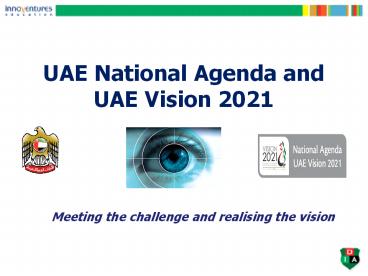UAE National Agenda and UAE Vision 2021 - PowerPoint PPT Presentation
1 / 17
Title:
UAE National Agenda and UAE Vision 2021
Description:
Title: Presentation Title Author: DIATECH Last modified by: hiteshb Created Date: 11/21/2013 3:32:43 AM Document presentation format: On-screen Show (4:3) – PowerPoint PPT presentation
Number of Views:897
Avg rating:3.0/5.0
Title: UAE National Agenda and UAE Vision 2021
1
UAE National Agenda and UAE Vision 2021
- Meeting the challenge and realising the vision
2
The UAE National Agenda
- In 2014, H.H. Sheikh Mohammed Bin Rashid Al
Maktoum, Vice President and Prime Minister of the
UAE and Ruler of Dubai, launched the UAE National
Agenda as an extension to achieve the UAE Vision
2021. - Education is a particularly important focus of
the UAE National Agenda as it includes eight key
objectives that will pave the way towards the
next phase of educational development in the UAE - These objectives should lead the UAE to become a
leading provider of world-class education.
3
The UAE National Agenda
- PISA to be among the 20 highest performing
countries - (The Programme for International Student
Assessment) - TIMSS to be among the 15 highest performing
countries - (Trends in International Mathematics and Science
Study) - High quality teachers to ensure that 100 of
schools have high quality teachers - Highly effective school leadership to ensure
that 100 of public schools have highly effective
school leadership
4
The UAE National Agenda Education Targets
- High skills in Arabic language to ensure that
90 of Year 10 Students develop high skills in
Arabic language in the UAE NAP (National
Assessment Programme) assessment - Completion of high school education to ensure
that 90 of Emirati students complete their high
school education - Attending pre-primary to ensure that 95 of
children in the UAE attend pre-primary education - University foundation programme to ensure that
no students need to join the university
foundation programme
5
The UAE Vision Education Targets
- Inclusion the UAE to become an inclusive,
barrier free, rights based society that promotes,
protects and ensures the success of all groups of
students - Innovation the UAE Vision 2021 sets out the
National Agenda for the UAE to be among the most
innovative nations of the world
6
What steps has DIA taken to meet the UAE
National Agenda targets and the UAE Vision 2021?
7
PISA how did we do in 2012?
8
PISA how did we do in 2012?
9
TIMSS how did we do in 2011?
Compared to Year 5 Mathematics Year 5 Science Year 9 Mathematics Year 9 Science
10
PISA TIMSS Targets
Year 5
Year 9
11
PISA TIMSS Meeting targets
- Curriculum
- Modified to meet the content and skill
requirements of TIMSS and PISA in mathematics
science - Revised our Learning Ladders to develop
threshold concepts for key learning aims - Mapped science outcomes throughout the primary to
ensure coverage - Daily mental maths activities to develop skills
- Real-life problem solving encouraged through the
KG and PYP curricula - Reviewed PYP Programme of Inquiry (POI) to ensure
better balance in all four strands of science in
each grade level - Guided reading programme introduced in primary
and modified set-texts in secondary
12
PISA TIMSS Meeting targets
- Learning, Teaching Assessment
- Personalised learning approach to ensure all
students are challenged - Use of Blooms-style questioning to promote
critical thinking - Introduced regular formative stop and check
assessments to more accurately determine student
starting points - Mathematics subject leaders model lessons and
deliver whole school PD - Science subject leader in Phase 2 models lessons
and drives curriculum development - Introduced PTE, PTM PTS Standardised
Assessments and embedded IBT - CAT4 for all students in Phases 2-4 to identify
SEN GT students for personalised learning, and
drive target-setting - TIMSS-styled assessments to ensure students are
familiar with the questions on a TIMSS test
13
PISA TIMSS Meeting targets
- Leadership Management
- Forensic data analysis to identify gaps, trends
and areas for intervention and improvement - Re-structured MYP streaming in maths to more
closely match student needs - Greater technology integration especially using
BYOD in secondary and iPads in Primary - Introduction of e-reading scheme in primary
- Regular learning walks to ensure teaching and
learning is always good or better - New science laboratory introduced in Primary, to
boost practical inquiry skills - Assistant Teachers introduced in Secondary Maths
and English
14
Improving the quality of Arabic education and
awareness
- Revised Arabic A and Arabic B curricula to match
Ministry requirements and the Modern Foreign
Language (MFL) framework - Revised Arabic Learning Ladders
- Greater variety of learning strategies employed
by a more highly qualified and skilled group of
teachers - Increased daily focus upon all four language
skills in every lesson - Arabic ASA and peer support groups
- Regular Arabic days
- Consistent success in group-wide competitions
- UAE Social Studies mapped and introduced in
secondary school humanities
15
University Success
- All DIA graduates admitted to university for the
7th consecutive year - 90 first-choice entrance in 2015
- 2015 graduate students admitted to the University
of Cambridge, London School of Economics (LSE),
Imperial College, and many other prestigious
university destinations across Europe, North
America, Australia and the Middle East
16
Inclusion
- Consistently Outstanding rating for Special
Educational Needs provision - Appointment of primary and secondary SEN
co-ordinators - Increased number of teaching assistants and
assistant teachers to support SEN students in
lessons - Greater use of student tracking data by teachers
to match learning to the needs of students - Use of CAT4 to improve identification of students
with additional learning needs, including Gifted
and Talented - Enhanced identification procedures in KG
17
Innovation
- Alternative learning spaces and environments
- BYOD embedded in Secondary
- E-learning and 1-to-1 embedded in upper primary
- Critical thinking and problem-solving intrinsic
to learning in all phases through higher order
questioning and metacognitive approaches

